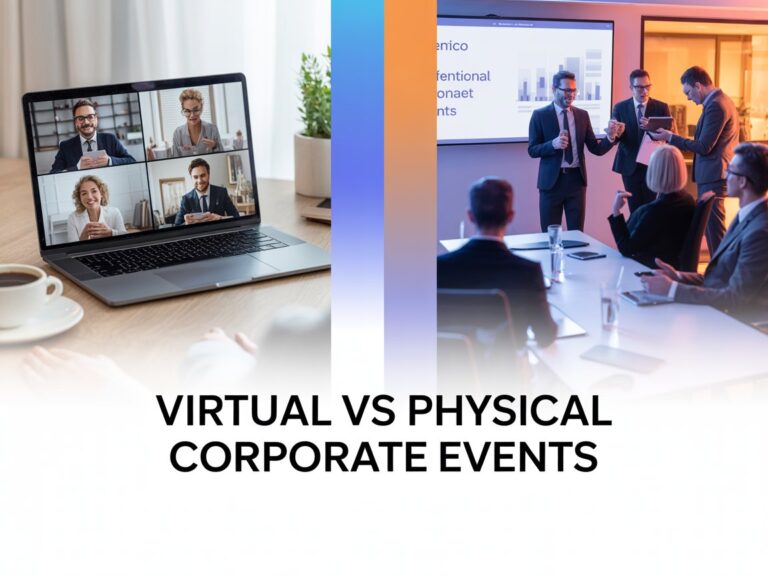
Virtual vs Physical Corporate Events: Pros and Cons
Corporate events are fundamentally about the act of uniting people around a common cause. From annual conferences to team recognition programs, these gatherings help reinforce company culture and strategic goals. However, the rapid adoption of remote work has brought virtual events to the forefront, changing how organisations engage their teams and clients. As the boundaries between digital and physical interactions continue to blur, businesses now evaluate both approaches carefully. This article examines the advantages and challenges of each format, offering insight into how companies can choose the most effective option for their objectives.
Understanding the Two Formats
A physical event brings people together in one venue where everything from lighting and sound to coordination is managed on-site. Organisers can observe participants directly, adjust in real time, and maintain a personal connection.
Virtual events, on the other hand, take place entirely online. They rely on stable internet connections, efficient moderation, and thoughtful planning to keep participants engaged. Both formats share the same objective to keep people engaged, but the way they do it feels completely different.
Pros of Virtual Corporate Events
Virtual corporate events offer numerous advantages for businesses aiming to connect teams, clients, and partners efficiently. Here are some of the key pros of hosting virtual corporate events:
Lower Operational Cost: Without venue rental, travel bookings, or hospitality costs, companies save significantly. The money often goes instead toward speaker fees, digital production, or marketing.
Global Accessibility: People don’t need to fly in or adjust to another city’s schedule. A simple login link gets them in. For companies with offices spread across countries, this is often the only practical way to get everyone in one “room.”
Flexible Scheduling: Virtual sessions don’t have to run for hours. You can break them into smaller slots across a few days, which helps with time zones and attention span. If someone misses a slot, they can still go through the recording later without holding up the rest of the team.
Scalable Participation: A digital room can expand quickly. Whether it’s fifty or five thousand attendees, there’s rarely a space limit.
Measurable Engagement: Most virtual platforms record logins, watch times, and feedback in real time. These numbers help organisers understand what worked and what didn’t.
Despite its advantages, the online formats continue to be unable to resist the natural energy and spontaneous networking of in-real-life events.
Cons of Virtual Corporate Events
While virtual corporate events offer many benefits, they also come with certain challenges that businesses should consider. Here are some of the key cons of virtual corporate events:
Reduced human connection: When communication happens entirely through screens, conversations often lose their natural rhythm and warmth.
Technical challenges: Even with good planning, there’s always a risk of weak internet, delayed audio, or people struggling to unmute at the right time. A small glitch can break the flow of an otherwise well-planned session.
Lower attention span: People log in from their work desks or kitchen tables, and something or the other keeps pulling their attention away. After a while, you can almost sense they’ve switched to checking emails.
Limited sensory experience: There is no décor, lights, or atmosphere to set the mood. Everything depends on what fits inside the screen frame.
Reduced brand recall: Virtual events often end without leaving a lasting impression. People remember the content but not the feeling. For many organisations, this absence of emotional connection is what often draws them back to in-person events.
Advantages of Physical Corporate Events
Physical corporate events offer unique opportunities for businesses to connect with employees, clients, and partners in ways that virtual events cannot fully replicate. Some of the key advantages include:
Stronger networking: Nothing replaces face-to-face interaction. People exchange ideas more openly when they meet in person, share a table, or talk between sessions.
Tangible brand experience: The design of the space, the sound, and even the lighting build a mood that reflects the brand’s identity. Guests remember how it felt, not just what was said.
Higher engagement: A live audience reacts in real time. That energy moves through the room and keeps the pace natural without extra prompts.
Memorable details: Guests may forget the presentation, but they remember the mood of the room and the way the place came alive.
Instant feedback: When a crowd applauds or stays silent, speakers sense it immediately and adjust. That instant exchange shapes the entire experience.
Many organisers still prefer physical gatherings; for this reason, the connection feels genuine and the response, unmistakably human.
Disadvantages of Physical Corporate Events
Below are the main disadvantages of organizing physical corporate events:
Higher cost: Organising a physical event demands a larger budget. Expenses for the venue, travel, and hospitality tend to escalate faster than expected.
Limited reach: If someone can’t travel, they miss out. Seats and schedules set a natural limit that online events don’t have.
Time and planning pressure: The synchronization of people, equipment, and vendors is time-consuming. It can take weeks of back and forth, even in a one-day event.
Environmental impact: Flights, banners, plastic bottles, it all leaves a mark. Many companies now track this more closely.
Unpredictable delays: Despite thorough preparation, unforeseen issues such as traffic or weather can still cause scheduling delays.
Most companies still choose live gatherings; direct presence often creates understanding and rapport that screens cannot replicate.
Conclusion
Whether it’s online or in person, the point of a corporate event stays the same: people need to connect and take something real back with them. Virtual works when time and distance are an issue. Physical events still matter when presence itself carries weight. Watermark Event Solutions plans each event with a clear purpose to ensure it delivers meaningful impact and meets its intended goals.
